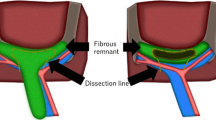Summary
BACKGROUND: Bile duct anastomotic stricture after bile duct injury or liver transplantation remains as the most formidable clinical problem. Here, we attempt to describe the natural course of healing following experimental end-to-end anastomosis (EEA) and to evaluate the efficacy and safety of EEA in a rabbit model. METHODS: New Zealand rabbits were divided into experimental groups with complete transection of the common bile duct (CBD) and control group with CBD mobilization. Clinical, laboratory biochemical and cholangiographical manifestations were compared between the groups. At intervals postoperatively healing course of the bile duct was judged by macroscopic, microscopic and transmission electron microscope examination. The diameters of CBD were measured by sliding caliper. RESULTS: Serum concentrations of alkaline phosphatase, alanine aminotransferase and total bilirubin were significantly higher in experimental groups than those in control group (P < 0.05). The cholangiogram showed that anastomotic stricture and markedly dilated biliary tree were observed at varying time postoperatively. Inflammatory reactions, cicatricial stricture and fibrosis in the bile duct wall were observed in the experimental groups. In addition, biliary fibroblast increased and collagen deposition was observed in the anastomotic scar tissue. We observed that 3 (6%) rabbits had formed gallstones within 1–3 months after injury EEA. CONCLUSIONS: This study demonstrated that microsurgical techniques could achieve successful primary end-to-end biliary repair in the rabbit. Anastomotic tension, surgical technology and fibrotic healing may be the most important causes of stricture formation. Additionally, this model may allow for researching the pathologic changes in the healing process of the bile duct and the mechanisms of stricture formation.
Similar content being viewed by others
References
Quintero GA, Patino JF. Surgical management of benign strictures of the biliary tract. World J Surg 2001;25:1245–50
Flum DR, Koepsell T, Heagerty P, et al. Common bile duct injury during laparoscopic cholecystectomy and the use of intraoperative cholangiography: adverse outcome or preventable error? Arch Surg 2001;136:1287–92
Tashiro H, Itamoto T, Sasaki T, et al. Biliary complications after duct-to-duct biliary reconstruction in living-donor liver transplantation: causes and treatment. World J Surg 2007;31:2222–9
Dalgic A, Moray G, Emiroglu R, et al. Duct-to-duct biliary anastomosis with a "corner-saving suture" technique in living-related liver transplantation. Transplant Proc 2005;37:3137–40
Rauws EA, Gouma DJ. Endoscopic and surgical management of bile duct injury after laparoscopic cholecystectomy. Best Pract Res Clin Gastroenterol 2004;18:829–46
Chapman WC, Abecassis M, Jarnagin W, et al. Bile duct injuries 12 years after the introduction of laparoscopic cholecystectomy. J Gastrointest Surg 2003;7:412–6
Wudel LJ, Wright JK, Pinson CW, et al. Bile duct injury following laparoscopic cholecystectomy: a cause for continued concern. Am Surg 2001;67:557–63, 563–4
McPartland KJ, Pomposelli JJ. Iatrogenic biliary injuries: classification, identification, and management. Surg Clin North Am 208;88:1329–43
de Reuver PR, Busch OR, Rauws EA, et al. Long-term results of a primary end-to-end anastomosis in peroperative detected bile duct injury. J Gastrointest Surg 2007;11:296–302
Rodriguez-Montes JA, Rojo E, Martin LG. Complications following repair of extrahepatic bile duct injuries after blunt abdominal trauma. World J Surg 2001;25:1313–6
Lau WY, Lai EC, Lau SH. Management of bile duct injury after laparoscopic cholecystectomy: a review. Anz J Surg 2010;80:75–81
Goykhman Y, Kory I, Small R, et al. Long-term outcome and risk factors of failure after bile duct injury repair. J Gastrointest Surg 2008;12:1412–7
Karvonen J, Gullichsen R, Laine S, et al. Bile duct injuries during laparoscopic cholecystectomy: primary and long-term results from a single institution. Surg Endosc 2007;21:1069–73
Jablonska B, Lampe P, Olakowski M, et al. Hepaticojejunostomy vs. end-to-end biliary reconstructions in the treatment of iatrogenic bile duct injuries. J Gastrointest Surg 2009;13:1084–93
Takatsuki M, Yanaga K, Okudaira S, et al. Duct-to-duct biliary reconstruction in adult-to-adult living donor liver transplantation. Clin Transplant 2002;16:345–9
Kawachi S, Shimazu M, Wakabayashi G, et al. Biliary complications in adult living donor liver transplantation with duct-to-duct hepaticocholedochostomy or Roux-en-Y hepaticojejunostomy biliary reconstruction. Surgery 2002;132:48–56
Ikegami T, Soejima Y, Shirabe K, et al. Evolving strategies to prevent biliary strictures after living donor liver transplantation. Transplant Proc 2010;42:3624–9
Pirenne J, Monbaliu D, Aerts R, et al. Biliary strictures after liver transplantation: risk factors and prevention by donor treatment with epoprostenol. Transplant Proc 2009;41:3399–402
Gamblin TC, Krasinskas AM, Slivka AS, et al. Fibroinflammatory biliary stricture: a rare bile duct lesion masquerading as cholangiocarcinoma. J Gastrointest Surg 2009;13:713–21
Bernhardt GA, Kornprat P, Schweiger W, et al. Late onset bile duct stricture caused by iatrogenic injury during laparoscopic cholecystectomy, mimicking cholangiocellular carcinoma. Endoscopy 2010;42(Suppl 2):E148–9
Marubashi S, Dono K, Nagano H, et al. Biliary reconstruction in living donor liver transplantation: technical invention and risk factor analysis for anastomotic stricture. Transplantation 2009;88:1123–30
Mullady DK, Carr-Locke DL. Traumatic biliary stricture. Medscape J Med 2008;10:114
Hall JG, Pappas TN. Current management of biliary strictures. J Gastrointest Surg 2004;8:1098–110
Kuroda Y, Tsuyuguchi T, Sakai Y, et al. Long-term follow-up evaluation for more than 10 years after endoscopic treatment for postoperative bile duct strictures. Surg Endosc 2010;24:834–40
Xu Z, Ling XF, Zhang WH, et al. Can pigment gallstones be induced by biliary stricture and prevented by medicine in Guinea pigs? World J Gastroenterol 2007;13:2703–6
Gonzalez RF, Bustamante MM, Conde FR, et al. Management of patients with iatrogenic bile duct injury. Cir Esp 2008;84:20–7
de Reuver PR, Busch OR, Rauws EA, et al. Long-term results of a primary end-to-end anastomosis in peroperative detected bile duct injury. J Gastrointest Surg 2007;11:296–302
Choi YS, Han HS, Yoon YS, et al. Laparoscopic end-to-end choledochocholedochostomy for bile duct injury during laparoscopic cholecystectomy. J Laparoendosc Adv Surg Tech A 2006;16:264–6
Jeffrey R, Jenkins DDA. Rabbit Diagnostic Testing. Journal of Exotic Pet Medicine 2008;17:4–15
Author information
Authors and Affiliations
Corresponding author
Rights and permissions
About this article
Cite this article
Tian, YH., Xu, Z., Zhang, XQ. et al. Development of an animal model for assessment of primary end-to-end biliary reconstruction. Eur Surg 44, 177–183 (2012). https://doi.org/10.1007/s10353-011-0047-6
Received:
Accepted:
Published:
Issue Date:
DOI: https://doi.org/10.1007/s10353-011-0047-6




